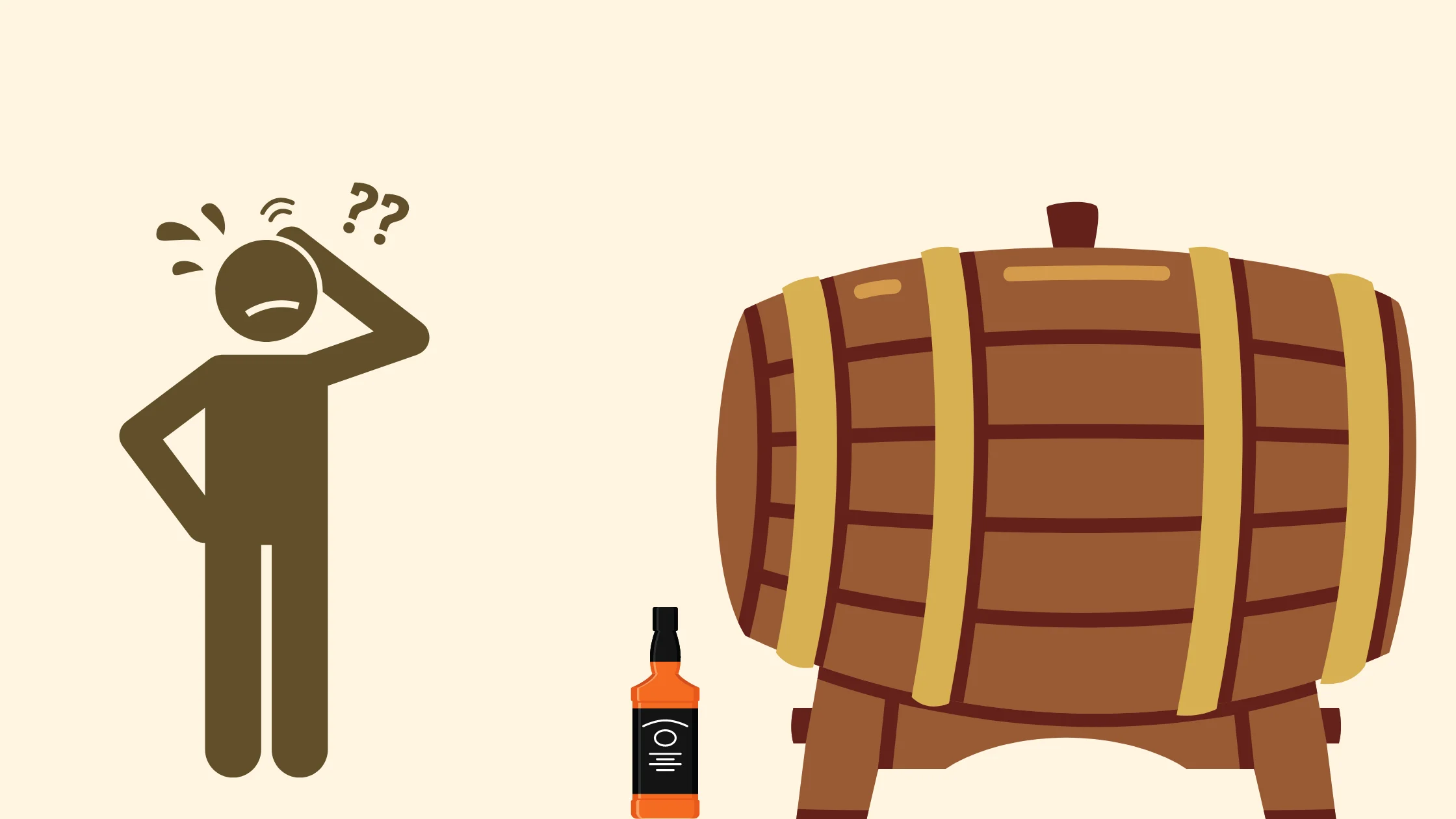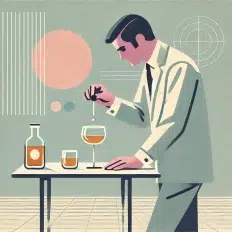Are you a whiskey enthusiast looking to preserve the rich flavors of your collection? Whether you’re a seasoned collector or a casual sipper, understanding the ins and outs of whiskey storage is essential. Proper storage isn’t just about keeping your whiskey in a cool, dark place; it involves a delicate balance of temperature, light exposure, humidity, and bottle positioning to maintain the spirit’s integrity and flavor profile.
From the importance of keeping your bottles upright to avoid cork deterioration to debunking common myths like freezing whiskey to enhance its quality, this article covers everything you need to know to keep your whiskey in prime condition. Dive into the world of whiskey storage with us, and ensure your collection remains as exquisite as the day it was bottled.
What is whiskey storage?
Whiskey storage refers to the methods and conditions under which whiskey is kept after it has been bottled, aiming to preserve its quality, flavor, and integrity over time. Proper storage is crucial for maintaining the whiskey’s characteristics as exposure to certain elements can lead to deterioration. The most important factors in whiskey storage include temperature, light, humidity, and positioning of the bottle.
Temperature plays a pivotal role, with a stable, cool environment being ideal to prevent the whiskey from undergoing unwanted chemical reactions that could alter its taste. Light, especially direct sunlight, can degrade the whiskey, affecting its color and flavor profiles. Hence, storing whiskey in a dark place is recommended.
Humidity levels also need to be controlled; too much humidity can damage the label and cork, potentially allowing air to seep into the bottle and oxidize the whiskey, while too little can cause the cork to dry out, also risking oxidation. The positioning of the whiskey bottle is another key aspect of proper storage. Bottles should be kept upright to minimize contact between the whiskey and the cork, which can prevent the cork from deteriorating and tainting the whiskey.
This is in contrast to wine storage, where bottles are typically stored on their side to keep the cork moist and expanded, ensuring a tight seal. Understanding the nuances of whiskey storage is essential for collectors and enthusiasts alike to ensure their whiskey remains in the best possible condition, preserving its intended flavor and quality for as long as possible. This knowledge is not only crucial for personal collections but also for bars, restaurants, and retailers who aim to offer top-quality whiskey experiences to their customers.
Why is proper whiskey storage important?
Proper whiskey storage is critical in preserving the flavor integrity of the spirit, preventing spoilage and contamination, and extending its shelf life while maintaining quality. The essence of whiskey’s complex flavor profile is safeguarded against degradation when stored correctly. This is vital for both unopened bottles, which can last indefinitely under the right conditions, and opened bottles, which are best consumed within 1-2 years to enjoy their optimal taste.
Furthermore, correct storage conditions, such as a consistent cool temperature, minimal light exposure, controlled humidity, and keeping the bottle upright, play a significant role in preventing the cork from deteriorating, which could otherwise lead to oxidation and evaporation. These factors collectively ensure the whiskey remains as close to its intended flavor and quality for the enjoyment of enthusiasts and connoisseurs alike, fulfilling the search intent for those looking to maintain or enhance their whiskey collection’s value and sensory experience.
Preserves flavor integrity
Proper storage ensures whiskey retains its intended complex flavors and aromas, crucial for the spirit’s overall quality.
Prevents spoilage and contamination
By maintaining optimal conditions, it minimizes the risk of the whiskey becoming tainted or spoiled, ensuring safety and enjoyment.
Extends shelf life, maintaining quality
Correct storage conditions allow whiskey, especially unopened bottles, to last indefinitely, preserving its value and taste over time.
Ideal conditions for whiskey storage
The ideal conditions for whiskey storage include maintaining a consistent cool temperature around 15-20°C (59-68°F), ensuring minimal light exposure by storing whiskey in a dark place or using tinted bottles, controlling humidity within the ideal range of 50-70%, and keeping bottles upright to prevent cork deterioration. These conditions help preserve whiskey’s flavor integrity, prevent spoilage, and extend its shelf life, aligning with the goal of maintaining or enhancing the quality of the whiskey for enthusiasts and collectors.
Consistent cool temperature
Around 15-20°C (59-68°F)
Maintaining a consistent, cool temperature is essential to prevent unwanted chemical reactions that could alter the whiskey’s taste.
Minimal light exposure
Store in a dark place or use tinted bottles
Limiting exposure to light, particularly sunlight, is crucial in preserving the whiskey’s color and flavor integrity.
Controlled humidity
Ideal range: 50-70%
Proper humidity levels ensure that the label and cork remain intact, preventing air from oxidizing the whiskey.
Bottle position
Upright to prevent cork deterioration
Bottles should be stored upright to minimize the whiskey’s contact with the cork, thus preventing the cork from deteriorating and tainting the whiskey.
Best containers for whiskey
The best containers for whiskey are glass bottles with tight seals, such as screw caps or cork stoppers, which effectively prevent oxidation and preserve the whiskey’s flavor. UV-protective tinted glass is particularly beneficial as it minimizes light exposure, further safeguarding the whiskey’s quality. For those looking to display or serve their whiskey elegantly, lead-free crystal decanters are suitable for short-term storage and serving, offering a balance between aesthetics and functionality.
These containers are pivotal in maintaining the integrity and quality of whiskey, aligning with the enthusiasts’ goal of preserving the spirit’s pristine condition.
Glass bottles with tight seals
Screw caps or cork stoppers
These seals are essential for preventing oxidation, thus preserving the whiskey’s distinct flavor and overall quality.
UV-protective tinted glass
Tinted glass significantly reduces light exposure, especially harmful UV rays, safeguarding the whiskey’s integrity and preventing flavor degradation.
Lead-free crystal decanters
For short-term storage and serving
Ideal for enhancing the whiskey drinking experience, lead-free crystal decanters are recommended for short-term storage and serving, offering both aesthetics and functionality without the long-term storage risks associated with lead contamination.
Environmental impact on whiskey
The environmental conditions surrounding whiskey storage significantly influence its quality and taste. Temperature fluctuations can cause the whiskey to expand and contract, potentially compromising the seal and leading to oxidation. Sunlight exposure is detrimental as it can lead to flavor degradation through the breakdown of complex molecules responsible for whiskey’s unique characteristics.
Additionally, storing whiskey in proximity to strong odors can alter its taste and aroma, as whiskey can absorb these external scents over time. Understanding and controlling these environmental factors are key to preserving the integrity and enjoyment of whiskey, catering to enthusiasts who seek to maintain their collection’s quality.
Temperature fluctuations
Avoid storing near heat sources
Stable temperatures are essential; fluctuations can compromise the whiskey’s integrity by affecting the seal and leading to oxidation.
Sunlight exposure
Leads to flavor degradation
Direct exposure to sunlight or intense artificial light can deteriorate the whiskey’s complex flavor compounds, significantly altering its intended taste.
Proximity to strong odors
Can alter whiskey’s taste and aroma
Whiskey has the ability to absorb surrounding scents over time, which can significantly change its original taste and aroma. It’s crucial to store whiskey in a neutral-smelling environment to preserve its unique characteristics.
Can whiskey go bad?
Whiskey, when properly stored, has an impressive shelf life, with unopened bottles potentially lasting indefinitely. However, once opened, whiskey is susceptible to oxidation, a process that gradually changes its flavor profile over time. Although not harmful, this can lead to a less enjoyable tasting experience.
Additionally, evaporation can occur, especially if the seal is not tight, leading to a loss of volume and potentially altering the whiskey’s proof. Therefore, while whiskey does not “go bad” in the traditional sense, its quality and characteristics can degrade, emphasizing the importance of proper storage to maintain its optimal condition.
Oxidation after opening
Changes flavor profile over time
Oxidation, initiated once the whiskey bottle is uncorked, gradually alters its flavor and aroma. This natural process can diminish the whiskey’s original qualities over time.
Evaporation
Loss of volume and potential proof reduction
Evaporation, especially in bottles with a compromised seal, results in a decrease in volume and can lead to a reduction in alcohol content, impacting the whiskey’s taste and potency.
Whiskey storage duration
The duration for which whiskey can be stored while maintaining its quality depends significantly on whether the bottle is opened or unopened. Unopened bottles of whiskey can last indefinitely if stored under the ideal conditions, preserving their quality and flavor for years, making them excellent additions to any collection. On the other hand, opened bottles are best enjoyed within 1-2 years to experience their optimal taste.
After opening, whiskey becomes prone to oxidation and evaporation, processes that gradually alter its flavor profile and potency. Proper storage practices, including minimizing exposure to light, maintaining a consistent temperature, and ensuring a tight seal, are crucial for extending the shelf life of both opened and unopened whiskey bottles.
Unopened bottles
Indefinitely, if stored properly
Unopened whiskey bottles have the potential to last indefinitely, preserving their quality and flavor, provided they are stored under the right conditions.
Opened bottles
Best consumed within 1-2 years
To ensure the optimal taste experience, it is recommended that opened bottles of whiskey be consumed within 1 to 2 years, as they are susceptible to oxidation and evaporation over time.
Tips for long-term storage
For the long-term storage of whiskey to maintain its quality and flavor, several key practices should be followed. Keeping bottles upright is crucial to prevent the cork from drying out and deteriorating, which could lead to oxidation. It’s also important to avoid transferring whiskey to different containers, as the original bottle is designed to maintain the spirit’s integrity best.
Regularly checking the seal integrity ensures that caps or corks remain secure, minimizing the risk of evaporation and external contamination. Adhering to these tips can significantly extend the life of both opened and unopened whiskey bottles, preserving their essence for future enjoyment.
Keep bottles upright
Prevents cork from drying out
Storing bottles in an upright position is crucial to prevent the cork from drying and deteriorating, which could allow air to enter and lead to oxidation.
Avoid transferring whiskey
Original bottle maintains integrity best
The whiskey’s original bottle is specifically designed to preserve its quality; transferring the whiskey to another container can compromise its integrity.
Check seal integrity regularly
Ensure caps or corks are secure
Regular checks of the seal’s integrity, ensuring that caps or corks remain tightly sealed, are essential to minimize the risk of evaporation and contamination.
Common whiskey storage myths
Several myths surround whiskey storage, often leading to misconceptions about preserving its quality. One prevalent myth is that freezing whiskey can improve its quality; however, this can actually dull the flavors, detracting from the whiskey’s complexity. Another common belief is that aging whiskey at home can enhance its flavor, but unlike wine, whiskey does not age once bottled, and its environment does not influence its maturity.
Additionally, the idea of storing whiskey in wooden barrels at home to improve quality is impractical; the aging process occurs in the distillery, and further aging in barrels outside this controlled environment does not yield the same results. Understanding these myths is crucial for enthusiasts seeking to maintain the integrity and enjoy the true essence of their whiskey collection.
Freezing whiskey
Does not improve quality; can dull flavors
Freezing whiskey is often mistakenly believed to enhance its quality. However, it can actually lead to dulled flavors, detracting from the whiskey’s intended complexity.
Aging whiskey at home
Whiskey does not age in the bottle
A common misconception is that whiskey can continue to age and improve in the bottle. In truth, whiskey ceases to age once it is bottled, meaning no further maturation occurs outside the distillery.
Storing in wooden barrels
Not practical for improving quality at home
Some might think storing whiskey in wooden barrels at home can enhance its quality. This practice, however, is not practical. Whiskey aging is a controlled process that occurs before bottling, and additional aging at home does not yield the same results.





